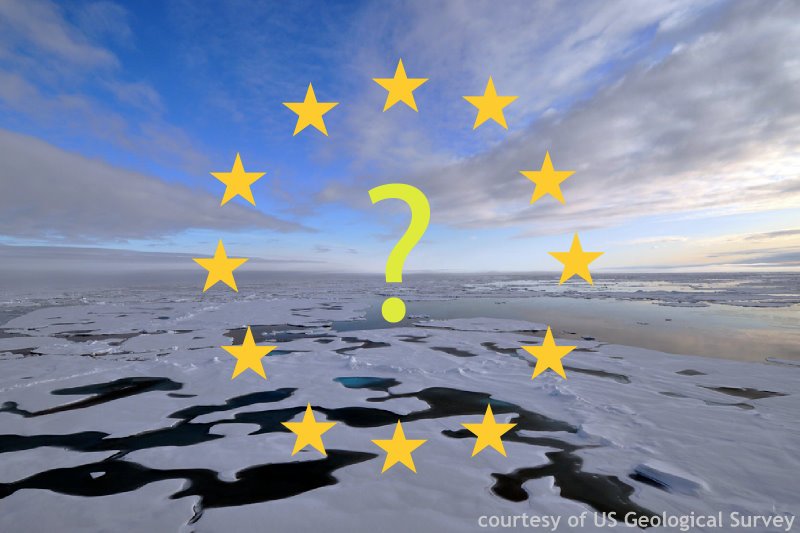The European Union and the Development of an Arctic Policy

Photo: The Arctic Institute
The thinning of the Arctic sea ice has attracted interest from political and scientific fields, with a focus on both preservation and usage. Whereas scientists have shown a deep concern for the climatic development, Arctic states have found an opportunity to develop new strategies to profit from the changing environment. Less ice and new technologies may result in new transport routes and improved access to natural resources. This in turn has lead to expectations of an upcoming ‘Scramble for the Arctic’.
The region has subsequently been portrayed as ‘unstable’ and ‘currently not governed by any specifically formulated multilateral norms and regulations’ in Brussels. On the other hand the five Arctic coastal states (A5) declared at Ilulissat in 2008 their willingness to settle conflicts peacefully by cooperation and dialogue. What also became apparent at Ilulissat was that the A5 were interested in keeping the governance of the region among themselves, thereby excluding other actors, among them the European Union. As portrayed by the Russian ambassador to the EU, Vladimir Chizhov; “We believe that in the foreseeable future consolidated efforts of the Arctic states are sufficient. Let me remind you that that there is no EU member state among the Arctic states.”
The EU is no obvious actor in the region, as the so-called race towards the North Pole concerns territories far beyond EU borders. The EU states with the most interests in the region, namely Denmark and Finland, have newly launched or re-polished independent Arctic strategies. Denmark has been particularly skeptical towards growing EU interference. The EU’s involvement in Arctic affairs has also created negative external reactions, as exemplified with the recent blocking of the EU’s bid for an observer status in the Arctic Council. Some of the Arctic states are therefore enquiring what purpose a European Arctic policy would serve and question the EU’s self portrayal of having a legitimate role in the region.
The EU’s approach, purpose, and legitimacy have seemingly been challenged, creating the puzzle of why it has started a policy development which there does not seem to be any apparent need or desire for.
The question put forward is why the EU is developing an Arctic policy at a supranational level, when there are numerous objections towards it regarding territory, purpose and internal and external state preferences. To explain such a policy development one has to conceptualize the different theoretical frameworks of foreign policy-making in the unique CFSP-system. The traditional focus on state primacy is not sufficient in contemporary EU policy studies, as the ‘nature of the beast’ has evolved beyond complete state sovereignty.
At the same time the idea that the state is sidestepped and subject to a spill-over between the supranational and the state level is inaccurate as the state still holds a strong primacy in foreign policy-making. Only by incorporating the behavior and individual preferences of the supranational institutions, alongside the interests of the member states, and the spill-over between high and low politics, can one explain why the EU is developing an Arctic policy.
An EU Arctic policy is subsequently being developed because the Commission seeks to expand its own influence and foreign policy expertise, and at the same time secure the EU’s position and interests in an upcoming “Scramble for the Arctic”. By expanding the EU’s external reach with a so-called regional policy enlargement, the Commission is also expanding its own reach into the domain of foreign policy. This goes hand in hand with the implementation of the Lisbon Treaty, the creation of a new European ‘foreign minister’ and the search for a stronger common European foreign policy.
An analysis of statements and interviews highlights how the supranational level has, in contrast to what has traditionally been theorized in foreign policy-making, served as an entrepreneur with an emphasis on the indispensable value of the EU in contentious and volatile issues in the Arctic. With a focus on sensitive and topical issues such as environment and governance, the Commission has attempted to create legitimacy for the EU’s involvement. However, due to the strategic importance of the region, some of the member states are playing an active role in policy development. This underlines the importance of the EU’s intra-institutional processes, and its status as a non-unitary and disjointed actor with several conflicting interests in the handling of a policy area as complex as the Arctic.
These factors may require new conceptualizations of the EU’s approach to foreign policy for the Arctic region, since a gap seems to exist between the rhetoric used in Brussels and the actual policy that is desired and created by the EU member states. It will be crucial to turn the focus on intra-institutional collaboration rather than the current intra-institutional competition, with recognition of this rhetorical gap, should the EU’s common aspirations in the Arctic become something more than just pipe dreams.
This argument may thus be part of a broader basis for further academic research on the relationship between the EU and the Arctic. This should be of relevance, as the Arctic region is a geographic area that that is rapidly becoming heated in the next couple of years, both literally and figuratively.
See the complete article: Østhagen, Andreas, 2011, “Utenrikspolitisk entreprenørskap – EU og utviklingen av en Arktis-politikk”, Internasjonal Politikk, Årgang 69, Nr. 1, side 7-35